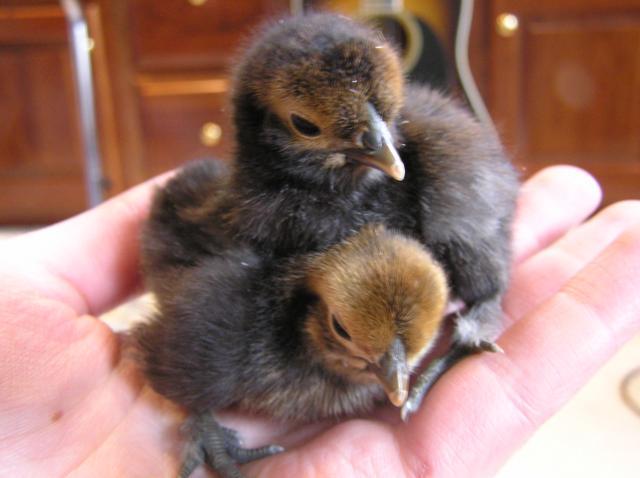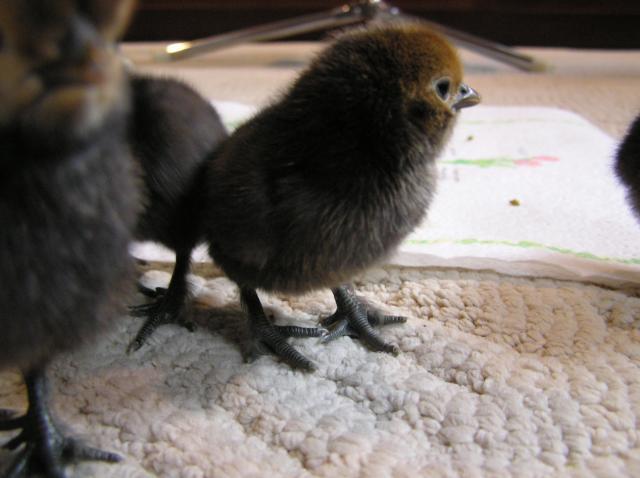Navigation
Install the app
How to install the app on iOS
Follow along with the video below to see how to install our site as a web app on your home screen.
Note: This feature may not be available in some browsers.
More options
You are using an out of date browser. It may not display this or other websites correctly.
You should upgrade or use an alternative browser.
You should upgrade or use an alternative browser.
My BLACK Leghorn x Rhode Island Red chick...
- Thread starter wjallen05
- Start date
- Thread starter
- #12
hmmm.... interesting! Thanks! Genetics are so neat.
- Apr 14, 2009
- 1,611
- 202
- 371
He/she is adorable! We got our first chickens at the end of April and I'm already waiting for them to be old enough to brood.
 Baby chicks are so cute!
Baby chicks are so cute!

I worked with dominant white for about six years- I had blue, mottling and barring segregate from my birds.
That would be interesting. The OPs birds could be any of those under the white, which will be interesting for them.

I done quite a bit with dominant too. Most often found barring under the white, which was useful.
Which leads me to a question, if you don't mind.
A few years ago I was breeding with some of those 'Cornish Cross' meat hybrids. Those particular pullets were dominant white & barred. Are they usually dominant white & barred or do they too vary?
That would be interesting. The OPs birds could be any of those under the white, which will be interesting for them.

I done quite a bit with dominant too. Most often found barring under the white, which was useful.
Which leads me to a question, if you don't mind.
A few years ago I was breeding with some of those 'Cornish Cross' meat hybrids. Those particular pullets were dominant white & barred. Are they usually dominant white & barred or do they too vary?
what are the chances that the dark chick will have white flicks in the feathers as it gets older?
I shouldn't think so. It may well have red leakage.
I shouldn't think so. It may well have red leakage.
The coloring remind me of some White Silkie x Golden Sebright mixes I hatched out in April this year.




Quote:
That would be interesting. The OPs birds could be any of those under the white, which will be interesting for them.

I done quite a bit with dominant too. Most often found barring under the white, which was useful.
Which leads me to a question, if you don't mind.
A few years ago I was breeding with some of those 'Cornish Cross' meat hybrids. Those particular pullets were dominant white & barred. Are they usually dominant white & barred or do they too vary?
I have been working with cornish cross and cornish cross hybrids for 4 years now. I have had blue segregate but not barring. It is not unusual to find barring in white birds. I know it will show up in wyandottes and rocks from time to time. Because cornish and leghorns are usually extended black or sometimes birchen at the E locus, barring helps to not only produce a white bird but also clears any black pigment from the shanks and feet.
Tim
That would be interesting. The OPs birds could be any of those under the white, which will be interesting for them.

I done quite a bit with dominant too. Most often found barring under the white, which was useful.
Which leads me to a question, if you don't mind.
A few years ago I was breeding with some of those 'Cornish Cross' meat hybrids. Those particular pullets were dominant white & barred. Are they usually dominant white & barred or do they too vary?
I have been working with cornish cross and cornish cross hybrids for 4 years now. I have had blue segregate but not barring. It is not unusual to find barring in white birds. I know it will show up in wyandottes and rocks from time to time. Because cornish and leghorns are usually extended black or sometimes birchen at the E locus, barring helps to not only produce a white bird but also clears any black pigment from the shanks and feet.
Tim
Thanks Tim, I shall just have to see. Are the Cornish hybrids usually dominant white? That is what I am hoping.
So.. I'm curious.. lol What did the little black chick turn out to look like?
New posts New threads Active threads
-
Latest threads
-
-
6 week old silkie; pullet or roo?
- Started by Unhingedchookmum
- Replies: 1
-
-
Update from the south, THIS is where im at..
- Started by sniper338
- Replies: 1
-
-
-
Threads with more replies in the last 15 days
-
-
BYC Software Update 2025
- Started by Nifty-Chicken
- Replies: 173
-
-
-
Anyone trained their dog to stay away from chickens like this?
- Started by ChickenShepherd_6116
- Replies: 70
-
×

